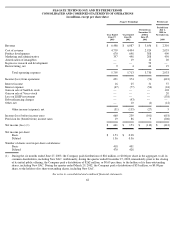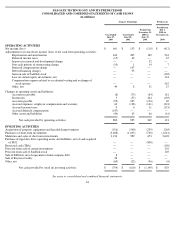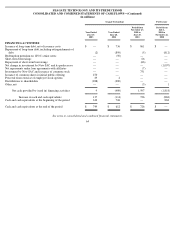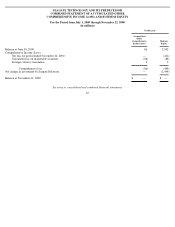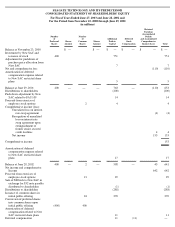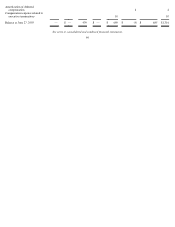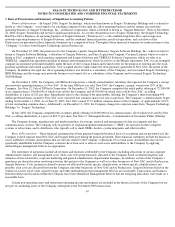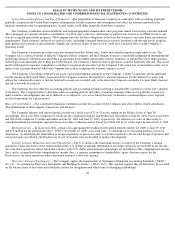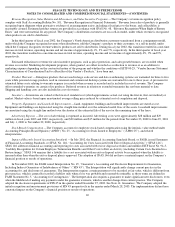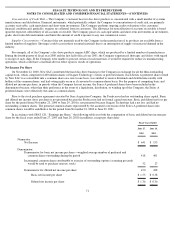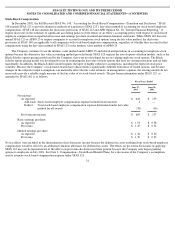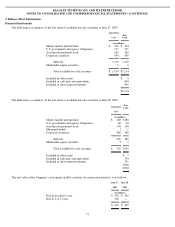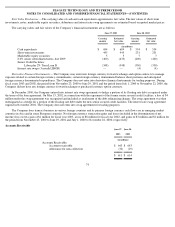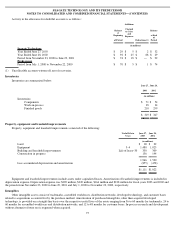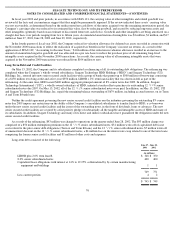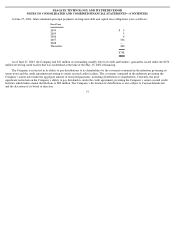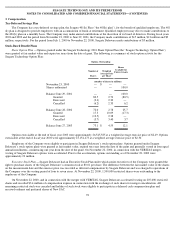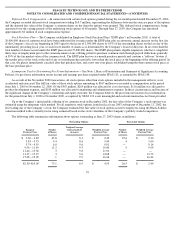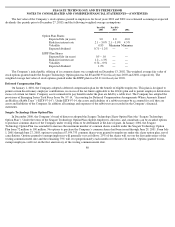Seagate 2002 Annual Report Download - page 77
Download and view the complete annual report
Please find page 77 of the 2002 Seagate annual report below. You can navigate through the pages in the report by either clicking on the pages listed below, or by using the keyword search tool below to find specific information within the annual report.
SEAGATE TECHNOLOGY AND ITS PREDECESSOR
NOTES TO CONSOLIDATED AND COMBINED FINANCIAL STATEMENTS—(CONTINUED)
Concentration of Credit Risk —The Company’s customer base for disc drive products is concentrated with a small number of systems
manufacturers and distributors. Financial instruments, which potentially subject the Company to concentrations of credit risk, are primarily
accounts receivable, cash equivalents and short-term investments. The Company performs ongoing credit evaluations of its customers’
financial condition and, generally, requires no collateral from its customers. The allowance for noncollection of accounts receivable is based
upon the expected collectibility of all accounts receivable. The Company places its cash equivalents and short-term investments in investment-
grade, short-term debt instruments and limits the amount of credit exposure to any one commercial issuer.
Supplier Concentration —Certain of the raw materials used by the Company in the manufacture of its products are available from a
limited number of suppliers. Shortages could occur in these essential materials due to an interruption of supply or increased demand in the
industry.
For example, all of the Company’s disc drive products require ASIC chips, which are produced by a limited number of manufacturers.
During the fourth quarter of fiscal year 2000 and the first half of fiscal year 2001, the Company experienced shortages and delays with regard
to receipt of such chips. If the Company were unable to procure certain of such materials, it would be required to reduce its manufacturing
operations, which could have a material adverse effect upon its results of operations.
Net Income Per Share
On November 22, 2000, New SAC contributed the hard disc drive business to the Company in exchange for all the then-outstanding
capital stock, which comprised of 400 million shares of Seagate Technology’s Series A preferred shares. Each Series A preferred share owned
by New SAC was convertible into a common share on a one-to-one basis, was entitled to receive dividends and distributions ratably with
holders of the common shares, and had voting rights on an as if converted to common shares basis. For the purpose of computing basic and
diluted net income per share, in periods when the Company has net income, the Series A preferred shares have been included in the
denominator because, other than their preference in the event of a liquidation, dissolution, or winding up of the Company, the Series A
preferred shares were effectively the same as common shares.
Prior to the stock purchase agreement executed by Suez Acquisition Company, the Predecessor had no outstanding share capital. Basic
and diluted net income (loss) per share is not presented because the Predecessor had no formal capital structure. Basic and diluted net loss per
share for the period from November 23, 2000 to June 29, 2001 is not presented because Seagate Technology had a net loss and had no
outstanding common shares. The potential common shares represented by the assumed conversion of the Series A preferred shares into
common shares would be antidilutive for the period from November 23, 2000 to June 29, 2001.
In accordance with SFAS 128, “Earnings per Share,” the following table sets forth the computation of basic and diluted net income per
share for the fiscal years ended June 27, 2003 and June 28, 2002 (in millions, except per share data):
71
Fiscal Years Ended
June 27,
2003
June 28,
2002
Numerator:
Net Income
$
641
$
153
Denominator:
Denominator for basic net income per share—weighted average number of preferred and
common shares outstanding during the period
418
401
Incremental common shares attributable to exercise of outstanding options (assuming proceeds
would be used to purchase treasury stock)
52
27
Denominator for diluted net income per share
470
428
Basic net income per share
$
1.53
$
0.38
Diluted net income per share
$
1.36
$
0.36


